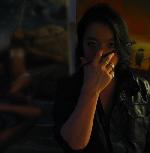ABOUT THE WORKS:
The Paled hair girls : Lust and Taste serious employ a visual language that is commu
nicated via a Generation Why perspective that characterizes the obsession with materialism and the vanity surrounding it . The archtectype is prevalent across Hong Kong pop culture since the early 2000s, from literature to movies , fashion and socials methods .
Moreover, Michael Andrew Law has taken the initiative to converse with the world by imbuing the canvas with suggestions of Traditional Chinese calligraphy and no longer confines himself to nostalgic traditional Classical-realism oil painting (which he spents 5 years in training) and achieves a breakthrough by including Abstract expressionism-like patterns and cartoonish line art which are familiar to a wider audience.
The paintings transport us into a chaotic figurative art populated with overlapping chinese calligraphy ,Action painting , Color field , casual but innocent girls or sometimes erotic ladies figures , glitter and clustered with object that symbolizing the love and hate relationship build between Hong Kong’s Post-80s generation and the chinese nation and traditions .
Michael Andrew Law is an artist who builds his singularity by observe and commentate the TYPICAL Generation Why (Post-80s Generation) conflicts between what he love and obsessed but afraid to show the love and to possess the quailty they long for ; he projects his desire as one of the Generation Why and displays this Hypocriticism through the paled hair girls , a legendary clan of female goddess who are untouchable from anyone whom obsessed with the vanity world , though they have everything they stand for is a vanity world’s obsessed the most.
For Michael Andrew Law ,theres always a question about the value judgments by persons who obsessed with vanity was often false and hypocritical , conflicting and incompatible .
Michael Andrew Law is drawn to young figures which often represents the psychological symbols of trust and innocent ,yet, which is also a part of hypocritical and conflicting act itself , thus, this act of hypocritical and conflicting gesture becomes his artist concept as much as an aesthetic principle , using young female , action paint and symbolism as a mode of expression ; Michael Andrew Law overcomes his own awkwardness and human fragility through his creative expression ,to embrace as a part of hypocritical and conflicting world of vanity .
Wrapped under the delicate and adorable features of hyperused of glitter effects and golden colours , as a metaphysical reference to a Gen Y pop-culture ,and a post-tv age reference .
Michael Andrew Law nevers hidess his love through the stone cold technique from his Classical-Realism trained background , highy influenced by artist like William-Adolphe Bouguereau for his figures painting, to the more social-commtating modern artists such as banksy , Michael Andrew Law ‘s Paled hair girl are simultaneously reflections of his solitude and a smoke of the complex emotions that lingers in his Generation Why Expressions .
Armaggddon Child :
A spin-off from the Pale-haired series, paintings used a Widescreen style composition ,as a commentary and question to the so called Rules of the sociality.
Michael Andrew Law nevers hidess his love through the stone cold technique from his Classical-Realism trained background , highy influenced by artist like William-Adolphe Bouguereau for his figures painting, to the more social-commtating modern artists such as banksy , Michael Andrew Law ‘s Paled hair girl are simultaneously reflections of his solitude and a smoke of the complex emotions that lingers in his Generation Why Expressions .
Armaggddon Child :
A spin-off from the Pale-haired series, paintings used a Widescreen style composition ,as a commentary and question to the so called Rules of the sociality.
Membership:
Nex-Gen Artist Association of Guangzhou
Hong Kong Arts Administrators Association
Selected Awards and Nominations:
Publishers Weekly Best illustrated ‘s Coffe Art Book 2004 ( Peter Perry )
The Salt and The Light -Church ‘s Children Art Book 2004 (Mars)
Borders Original Voices nominee 2006 (Dear Fish Eye)
Publisher’s Weekly Best Children’s Book list 2004 (China the Beautiful)
Communication Digital Artist — Award of Excellence
Print Weekly Design Annual Awards (2000,2002)
Face to face Dolphin art competition silver award 2006 (Hong Kong)
Art Directors of HKC Award of Merit (2005)
Society of Fine Art — An exhibitor 2005 Society of Newspaper Design Award of Excellence
Michael and Stephanie Duo Exhibition (2006)
Spectrum Fantastic Art Annual (multiple)
not-for-profit aution for Rotary of HK 2012
Selected Exhibition:
2013 Detour Matters 2013 and December to Remember 2013
2012 Park Central tseung kwan O at Hong Kong
2011 Art fair at Discovery Bay , Hong Kong
2011 HK Gold Coast (Book signing exhibition)
2009 Exhibition The Avenue of Stars
2008 Group Exhibition of Classical Realism class of 2008 at Manhattan,NY
2007 Hong Kong Art Fair
2007 Guest and ExhibitionThe Peak Galleria Hong Kong
2007 Invited workshop exhibition, Elements, Hong Kong
2007 Group Exhibition of Classical Realism class of 2007 at Manhattan,NY
2006 Group Exhibition of Classical Realism class of 2006 at East Village, Manhattan,NY
2006 Collection by Cardinal Zen Ze-kiun and exhibited at Catholic Church of Hong Kong.
2004 – 2007, Exhibition, Hong Kong Central Library.
2005 Illustrator for Kung Kao Po
2004 Group Exhibition, Wanchai Tower
2003 Group Exhibition, Hong Kong Convention and Exhibition Centre.
2003 Winner of I luv Hong Kong Painting Competition, exhibition at The Landmark (Hong Kong).
關於藝術家 :
羅卓睿(Michael Andrew Law)曾隨紐約畫家 Daniel Anderson (1928-2008) 學古典畫,作品橫跨不同媒體 ,包括繪畫,攝影,視頻及服装, 其繪畫將現代人虛偽,崇拜浮華及時尚等概念並列對照 . 藝術家喜愛揭示對謊言及偽裝與文化和價值之間令人着迷而不可分割的關系.
關於作品 :
[白髮系列] 是近年最耗費心思的作品糸列 , 創作計劃早於2006年開始構思和規劃, 創作歷時超過六年並仍在繼續 ,作品包括百多件油畫 ,漫畫 ,照片和視頻 .
創作概念是源於一系列香港上一代對回歸後的新世代之批評和反思 , 對社會新舊世代各自均過份迷信表象,崇拜氛圍和地位 , 然而又各自裝着予道德觀念和自我價值的堅持的有趣現像.
整個系列環繞着觀眾對文化相對物質主義等圖騰的聯想及反應而非畫面本身.
[ 末日的孩子] 是白髮系列中一個以末日為圖騰的組画 ,以闊銀幕式畫面評論及對社會上所謂自上下束成的框框提出質疑.
Note:All Michael Andrew law artworks, names, images, likenesses, slogans, gestures, trademarks, logos and copyrights are the exclusive property of LAW CHEUK YUI and its subsidiaries. All other trademarks, logos and copyrights are the property of their respective owners. c 2011 Michael Andrew Law, Inc. All Rights Reserved.
The textual, photographic, video, audio, and combined audiovisual programs and products resulting from Michael Andrew Law’s Artworks and products including the material contained in this web site, are protected under Hong Kong,SAR,China and international laws as copyrighted works. Anyone who displays, reproduces, copies, creates derivative works, or sells our textual, photographic, video or audiovisual programs for commercial or non-commercial purposes without our permission violates the copyright laws and is liable for copyright infringement
2014 Workshops
If you’re considering a workshop for paintings, email me with any questions. I hope to paint with you in 2014.
如果你正在考慮為一個學畫的工作室,可立即發電子郵件給我。我希望能在 2014年與你繪畫。
FREE Michael Andrew Law painting Poster for You
Hope you enjoy it, and feel free to share it with your friends.
免費Michael Andrew Law桌面海報送俾你:
希望你喜歡它,並歡迎隨時與朋友分享。
Best,












